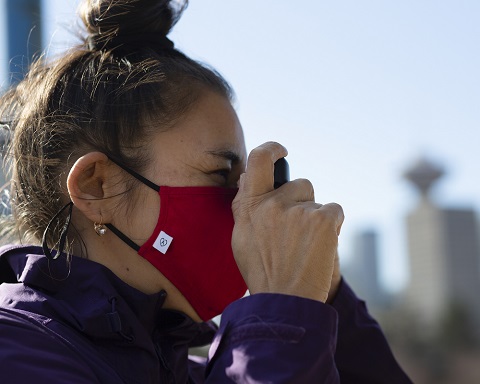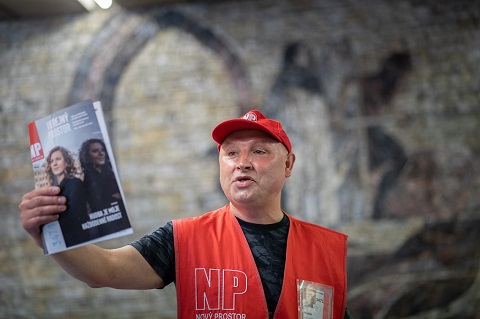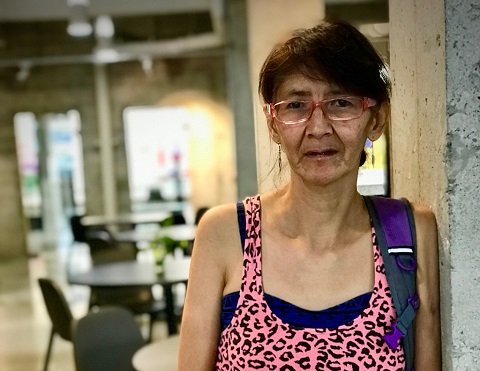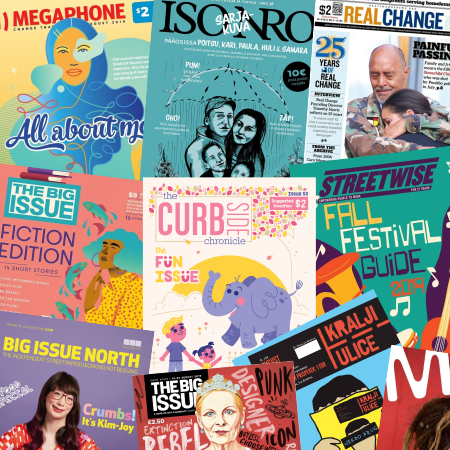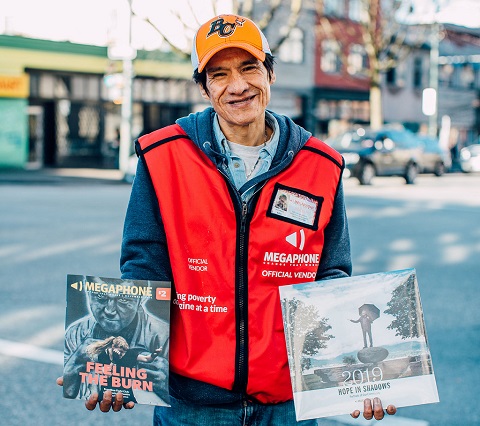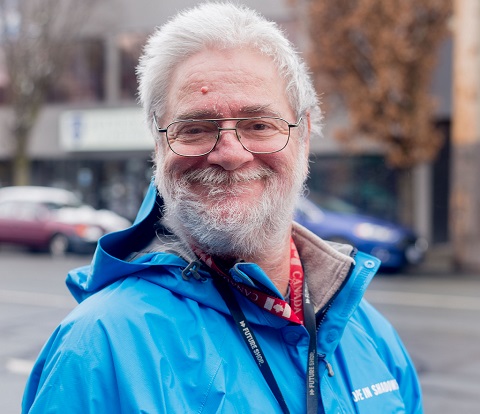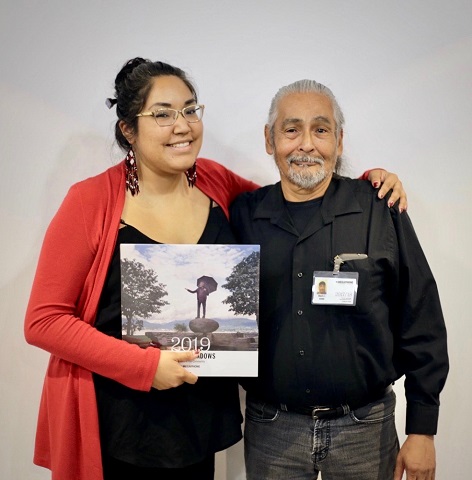The thought of moving your wedding day to avoid missing a street paper summit may sound bizarre to some. But not for departing executive director Sean Condon. “It was a brief thought in my mind,” admits Sean “…which never got articulated to my wife.”
The wedding went ahead as planned, as did the summit in Seattle. Yet this snippet gives an insight into the ten-year tale of commitment from this man to one of Vancouver’s most successful social enterprises.

Before hanging up his hat at the helm last week to move onto a new role supporting social enterprises, Sean shared with INSP a decade of stories which include early photocopied Vancouver street papers, the uplifting tale of Vancouver vendor Bob, and that ‘tough’ decision of wedding versus summit.
First as editor then executive director, Sean has played his part in the evolution of Vancouver’s street paper history. Back in early 2000s, Sean was a freelance journalist – but he was intrigued when he saw street paper vendors in his local area. Those vendors were selling The Street – a successor to the city’s first street paper, Spare Change.
Spare Change had been going since 1992, not long after The Big Issue had taken the world by storm. But after several years of success it splintered into two smaller papers. When a friend of Sean’s took over The Street, it had just a handful of vendors selling stapled photocopied issues across the city. He picked up the phone to Sean, who was poised to step into the editorial breach. He hasn’t looked back since and 2015 circulation figures spotlight Megaphone’s growth, with an average of 40 vendors having sold an average of 3,500 magazines monthly.
“It was exactly what I was hoping journalism and a street paper organisation could be”
Compared to writing freelance articles, Sean could immediately see the advantages of being in the thick of developing a street paper.
“I was doing a lot of stories at the time about an area that was being heavily gentrified but had a lot of health, poverty and addiction issues,” he says. “It was devastating to see people losing their homes and being kicked out and so many struggling and not getting their fair rights.
“It was hard to know what impact my stories at the time were having because it wasn’t stopping the developments or the evictions. But when I got really involved with the street paper it was amazing because not only could we cover these stories we could really empower the community, through the income and the writing of the stories.
“It was a great honour to be a part of that more intimately and seeing what it meant to people to be empowered. It was exactly what I was hoping journalism and a street paper organisation could be.”

From that development period, Sean credits the support he received from the worldwide network of street papers. Sean was heavily involved with both INSP and the North American Street Newspaper Association (NASNA), which merged into INSP in 2013.
He says, “In those early years, I really didn’t have a great understanding of how to run a street paper project. I leaned very heavily on the network.” In 2016, Megaphone is one of the 112 street papers that INSP supports across 35 countries.
Sean adds, “I was very appreciative of how really open and helpful everyone was. Being in Vancouver, we were very lucky to have Real Change in Seattle and Street Roots in Portland. Anyone I ever contacted was always very giving of their time and advice. And the conferences were always really informative. I don’t know what I would have done without that network. I guess I would have been pretty lost.”
As the years went by, technology provided ever increasing ways to keep in touch with international colleagues. Sean is particularly fond of the INSP member group on Facebook, which offers a space for street paper staff to exchange ideas.
“The strength of the network is so key to the success of the street paper movement globally”
“Having Facebook groups means you can have eight people respond and they become connected and so on, making engaging with people so much easier,” he explains.
“That’s really strengthened the movement in many ways, not falling back on seeing people only every year at the conference. The strength of the network is so key to the success of the street paper movement globally.”
One occasion Sean’s vocation awkwardly clashed with his personal life occurred last year, when the Global Street Paper Summit in Seattle fell on the same week as his wedding. In the end his bride-to-be won out over the street paper gathering – but it was closer than you might expect.
“I think I was just a bit disappointed. I’d been talking for so long about having a conference here in North America again,” he says.
“There sometimes feels that there has been a divide between North America and Europe, so having the conference in Seattle was really special and an opportunity. To miss it was pretty disappointing, but yeah obviously the wedding was fantastic, so…”

As Sean steps away, he says his decision was made easier knowing the strength of Megaphone’s current team. Filling his shoes is Jessica Hannon, who has five years of experience with the paper, moving from volunteering to vendor coordinator to operations manager.
Sean adds, “There is also a new vendor coordinator and development officer who will bring a ton of experience and energy. That’s made it a lot easier for me leaving to know it’s all in good hands with a team which has a passion for the vendors and in keeping Megaphone pushing forward.”
Sharing one story that epitomises the impact of street papers, Sean says, “One experience I have involves a vendor named Bob, who had been selling the paper for some time. Bob has schizophrenia, and was struggling with depression. He was going through a particularly bad bout when he tried to commit suicide by taking a lot of pills that put him in a coma in the hospital for a month.”
Once Bob returned to his vendor spot, many of his customers were upset hearing about his experience. They asked, ‘how can we help Bob?’
“So Bob is a fan of old western movies,” Sean continues, “particularly Gunsmoke. So they started to have what became ‘Gunsmoke nights’, by going over to Bob’s house to watch his TV where he ‘curates’ the shows. Sometimes he gets so excited he gives away the ending away.”
Sean went along to one of the Gunsmoke nights and was amazed to see Bob’s customers from some of Vancouver’s most affluent areas hanging out and having a great time. “It meant the world to Bob,” Sean says, “and meant a great deal to the customers too, as they got to connect with him.”

Sean is convinced that this is what street papers are all about: building connections between people and communities, and providing a conduit for social change. He adds, “With so much technology, it’s hard to keep face-to-face relationships in street papers going, but this was a great example of bringing people together who otherwise would not have [met], had it not been for the street paper.”
With a decade of experience and wisdom behind him, what advice would Sean give to anyone setting out to make a new street paper? “Lean heavily on the network and your fellow street papers to learn how they’ve done it; how they got through those early years and what the long vision is,” he says.
“That is what is so amazing about this network in that you don’t need to reinvent the wheel. There are these wonderful partners who want to see you succeed and impart all their wonderful wisdom and advice.
“Just be patient, talk to people about it and get through it.”




